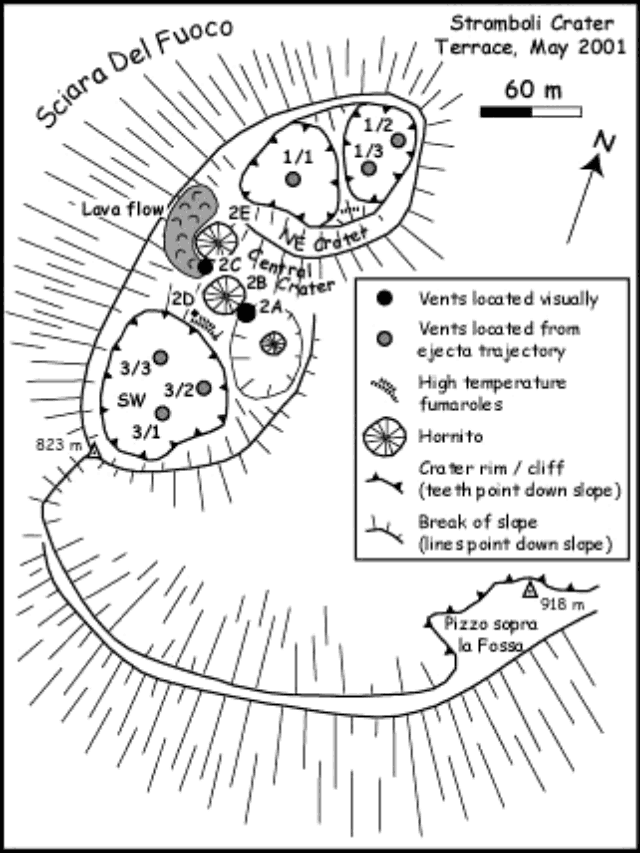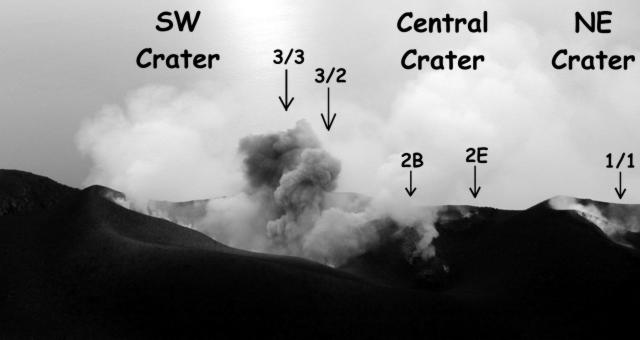Report on Stromboli (Italy) — July 2001
Bulletin of the Global Volcanism Network, vol. 26, no. 7 (July 2001)
Managing Editor: Richard Wunderman.
Stromboli (Italy) Continued Strombolian activity during March-May 2001; crater morphology changes
Please cite this report as:
Global Volcanism Program, 2001. Report on Stromboli (Italy) (Wunderman, R., ed.). Bulletin of the Global Volcanism Network, 26:7. Smithsonian Institution. https://doi.org/10.5479/si.GVP.BGVN200107-211040
Stromboli
Italy
38.789°N, 15.213°E; summit elev. 924 m
All times are local (unless otherwise noted)
This report discusses the period March-May 2001, which included a 10-day interval of field observations. Observers and instruments documented variable volcanism and seismicity ongoing since the last report (BGVN 26:04).
Seismic activity increased in early March, as recorded by the University of Udine summit station, which is located 300 m from the craters at 800 m elevation. On 13 March the number of events per day reached 200. The latter half of March was characterized by a decrease of tremor intensity and by a noteworthy number of saturating events (peaking at 63 on 20 March). In April a reprise of the tremor intensity occurred but the number of triggering seismic events decreased. May was characterized by an increased number of seismic events.
During 14 days (10-24 May) of continuous seismic, thermal, and infrasonic measurements, the authors recorded a detailed 16-hour-long log of activity, and they updated the crater terrace map (figures 65 and 66). During the period, 1,050 seismically determined Strombolian events were recorded overall. These came from the NE, Central, and SW craters, with respective craters discharging 463, 42, and 545 events, respectively. These data provide an average daily rate (over the 62-hour period) that ranged from 5 to 31 events/hour and averaged 17 events/hour. Thus, the average repose time between eruptions was ~3.5 min; the largest measured repose time for the three vents was 22 minutes.
Breaking these statistics down by individual crater, the NE, Central, and SW craters had respective daily averages that ranged as follows: 2-21, 0-3, and 1-19 events/hour. The crater's average event rates were 8, 1, and 9 events/hour, respectively. This gives average repose times for the craters of 8, 69, and 7 min, respectively. For comparison, the maximum repose times at NE, Central, and SW craters were 46, 420 and 105 minutes.
As in May 2000 (BGVN 25:08), the NE Crater consisted of two smaller pits separated by a low septum, the two pits being the location of one and two active vents, respectively. Of these, the western-most vent (1/1) and eastern-most vent (1/2) were most active, with average rates of 4 and 3 events/hour, respectively, compared with ~1 event/hour for vent 1/3. The SW crater contained three active vents that often showed paired or synchronous activity. However, the exact combination of paired eruptions varied daily. For example, on 16 May, an eruption from 3/1 would often be followed by one from 3/2 within a few seconds; but, on 19 May, an eruption from 3/1 would be followed by one from 3/3. As in previous years, eruptions from the SW crater had longer durations and were richer in ash than those from the NE crater.
The frequency and style of activity at the NE crater showed significant variations. During 10-11 May, the NE crater erupted up to 10 times/hour. Events at vent 1/1 were characterized by single-shot, ejecta-loaded Strombolian eruptions, while those at vent 1/2 were long duration (typically 10-20 s), gas-rich eruptions with diffuse ejecta sprays. During 14-15 May, the eruption rate increased to 12-17 events/hour, as eruptions at 1/1 switched to longer duration (~10 s), gas-rich ejections mixed with ash and small bombs. At the same time, events from vent 1/2 contained more bombs that reached ~300 m above the crater. On 16 May, maximum eruption rates declined to 8 events/hour, and ejections from 1/1 and 1/2 were characterized by diffuse sprays of small incandescent bombs mixed with ash to ~200 m. During 17-20 May, activity from both vents was characterized by strong eruptions, often occurring in multiple pulses, with heavy bomb loads to 200-300 m above the crater, and maximum eruption rates of 21 events/hour. Activity declined by 21 May and, by 23 May, activity consisted of gas-rich eruptions with rare-to-no bombs and maximum eruption rates of 5-6 events/hour.
During 11-20 May, the eruption rate at the SW crater increased from 1-12 events/hour (11-16 May) to 6-19 events/hour (18-20 May). Events were typified by 20- to 40-second-long emissions of gas, ash, and bombs. During this period, the ash component appeared to decline and the bomb component appeared to increase. The area inundated by bombs gradually increased, reaching the outer flank of the NE crater by 17 May. Activity peaked on 22 May when strong eruptions with heavy bomb loads were observed. At this time bombs hit the cliff below the Pizzo Sopra la Fossa and cleared the lower section of the pizzo ridge where the lowest tourist shelters are located. Bombs ~0.5 m in diameter fell within 20 m of that location and the path was littered with fresh scoria tens of centimeters in diameter. By 23 May, activity had changed entirely with the eruption rate down to 5-6 events/hour and activity characterized by gas- and ash-rich ejections with few or no bombs.
The Central Crater had evolved significantly since May 2000, when the a funnel-shaped pit that had developed during 1997-99 in the SE sector of the crater (BGVN 24:06) was active with a single degassing vent only (BGVN 25:08). Over the intervening period this pit has filled and now has an inactive hornito. Since May 2000, a new hornito (2B) has developed on the rim of this pit, with a 5-10 m wide vent (2A) at its base. The 2A vent was incandescent by night and radiometer-measured temperatures were in the range 726-577°C.
The summit of the 2B hornito was occupied by an open vent that was the source of continuous gas emission with weakly formed puffs, but no eruptions during the observation period. Vent 2A was the source of vigorous degassing with well-formed puffs. Frequent vigorous phases here often sent one or two pieces of scoria to a height of 10 m above the vent rim. This vent was also the location of rare Strombolian explosions, with just 11 observed during the entire 62-hour observation period.
A new ~2 m wide vent (2C) had also opened towards the center of the Central Crater, and appeared to be the source of a small lava flow that was not observed during May 2000. The surface shows a pahoehoe form, and the flow extends around the base of the inactive hornito 2E and laps up against the back wall of the Crater Terrace (figure 65). Vent 2C was also the source of rare (24 over the entire observation period) Strombolian eruptions, characterized by loud, emissions that created well-formed column-shaped ejecta-bearing plumes.
Explanation of seismic events. In the discussion above, the number of seismic "events" is not directly comparable to the number of "eruptions" for two reasons. First, not all eruptions produce a seismic signal in the frequency range recorded by the short-period seismometer installed by University of Udine. Second, the seismic acquisition at Udine employs a trigger algorithm, which, although not perfectly efficient, has been kept constant since the installation of the 3-component station in 1992 to guarantee coherency between the graphs presented in the Bulletin.
Geological Summary. Spectacular incandescent nighttime explosions at Stromboli have long attracted visitors to the "Lighthouse of the Mediterranean" in the NE Aeolian Islands. This volcano has lent its name to the frequent mild explosive activity that has characterized its eruptions throughout much of historical time. The small island is the emergent summit of a volcano that grew in two main eruptive cycles, the last of which formed the western portion of the island. The Neostromboli eruptive period took place between about 13,000 and 5,000 years ago. The active summit vents are located at the head of the Sciara del Fuoco, a prominent scarp that formed about 5,000 years ago due to a series of slope failures which extends to below sea level. The modern volcano has been constructed within this scarp, which funnels pyroclastic ejecta and lava flows to the NW. Essentially continuous mild Strombolian explosions, sometimes accompanied by lava flows, have been recorded for more than a millennium.
Information Contacts: Andy Harris, Department of Earth Sciences, The Open University, Milton Keynes, MK7 6AA, U.K.; Roberto Carniel, Dipartimento di Georisorse e Territorio, Università di Udine, via Cotonificio 114, I-33100 Udine, Italy (URL: http://www.swisseduc.ch/stromboli/); Maurizio Ripepe, Dipartimento di Scienze della Terra, Università di Firenze, via G. La Pira 4, I-50121 Firenze, Italy; Emanuele Marchetti, Dipartimento di Scienze della Terra, Università di Firenze, via G. La Pira 4, I-50121 Firenze, Italy; John Bailey, Department of Geology and Geophysics, SOEST, University of Hawai'i, 2525 Correa Road, Honolulu, HI 96822, USA; Scott Rowland, Department of Geology and Geophysics, SOEST, University of Hawai'i, 2525 Correa Road, Honolulu, HI 96822, USA; Jürg Alean, Kantonsschule Zürcher Unterland, CH8180 Bülach, Switzerland; Dave Rothery, Department of Earth Sciences, The Open University, Milton Keynes, MK7 6AA, U.K.; Jonathan Dehn, University of Alaska Fairbanks, 903 Koyukuk Drive, Fairbanks, AK 99775, USA; Stromboli On-line, maintained by Jürg Alean and Roberto Carniel (URL: http://www.swisseduc.ch/stromboli/).



